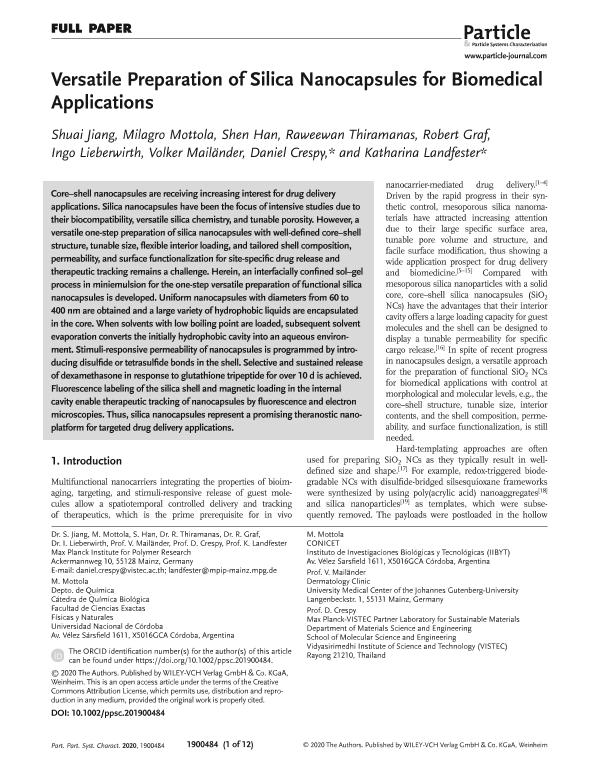Mostrar el registro sencillo del ítem
dc.contributor.author
Jiang, Shuai
dc.contributor.author
Mottola, Milagro

dc.contributor.author
Han, Shen
dc.contributor.author
Thiramanas, Raweewan
dc.contributor.author
Graf, Robert
dc.contributor.author
Lieberwirth, Ingo
dc.contributor.author
Mailänder, Volker
dc.contributor.author
Crespy, Daniel
dc.contributor.author
Landfester, Katharina
dc.date.available
2021-02-12T02:53:13Z
dc.date.issued
2020-04-14
dc.identifier.citation
Jiang, Shuai; Mottola, Milagro; Han, Shen; Thiramanas, Raweewan; Graf, Robert; et al.; Versatile preparation of silica nanocapsules for biomedical applications; Wiley VCH Verlag; Particle & Particle Systems Characterization; 37; 4; 14-4-2020; 1-12; 1900484
dc.identifier.issn
0934-0866
dc.identifier.uri
http://hdl.handle.net/11336/125538
dc.description.abstract
Core–shell nanocapsules are receiving increasing interest for drug delivery applications. Silica nanocapsules have been the focus of intensive studies due to their biocompatibility, versatile silica chemistry, and tunable porosity. However, a versatile one-step preparation of silica nanocapsules with well-defined core–shell structure, tunable size, flexible interior loading, and tailored shell composition, permeability, and surface functionalization for site-specific drug release and therapeutic tracking remains a challenge. Herein, an interfacially confined sol–gel process in miniemulsion for the one-step versatile preparation of functional silica nanocapsules is developed. Uniform nanocapsules with diameters from 60 to 400 nm are obtained and a large variety of hydrophobic liquids are encapsulated in the core. When solvents with low boiling point are loaded, subsequent solvent evaporation converts the initially hydrophobic cavity into an aqueous environment. Stimuli-responsive permeability of nanocapsules is programmed by introducing disulfide or tetrasulfide bonds in the shell. Selective and sustained release of dexamethasone in response to glutathione tripeptide for over 10 d is achieved. Fluorescence labeling of the silica shell and magnetic loading in the internal cavity enable therapeutic tracking of nanocapsules by fluorescence and electron microscopies. Thus, silica nanocapsules represent a promising theranostic nanoplatform for targeted drug delivery applications.
dc.format
application/pdf
dc.language.iso
eng
dc.publisher
Wiley VCH Verlag

dc.rights
info:eu-repo/semantics/openAccess
dc.rights.uri
https://creativecommons.org/licenses/by-nc-sa/2.5/ar/
dc.subject
CONTROLLED RELEASE
dc.subject
CORE–SHELL NANOCAPSULES
dc.subject
DRUG DELIVERY
dc.subject
SILICA NANOCARRIERS
dc.subject
THERANOSTIC NANOPLATFORMS
dc.subject.classification
Química Coloidal

dc.subject.classification
Ciencias Químicas

dc.subject.classification
CIENCIAS NATURALES Y EXACTAS

dc.subject.classification
Nano-materiales

dc.subject.classification
Nanotecnología

dc.subject.classification
INGENIERÍAS Y TECNOLOGÍAS

dc.title
Versatile preparation of silica nanocapsules for biomedical applications
dc.type
info:eu-repo/semantics/article
dc.type
info:ar-repo/semantics/artículo
dc.type
info:eu-repo/semantics/publishedVersion
dc.date.updated
2021-01-18T15:45:39Z
dc.identifier.eissn
1521-4117
dc.journal.volume
37
dc.journal.number
4
dc.journal.pagination
1-12; 1900484
dc.journal.pais
Alemania

dc.journal.ciudad
Weinheim
dc.description.fil
Fil: Jiang, Shuai. Max Planck Institute for Polymer Research; Alemania
dc.description.fil
Fil: Mottola, Milagro. Universidad Nacional de Córdoba. Facultad de Ciencias Exactas, Físicas y Naturales. Departamento de Química. Cátedra de Química Biológica; Argentina. Consejo Nacional de Investigaciones Científicas y Técnicas. Centro Científico Tecnológico Conicet - Córdoba. Instituto de Investigaciones Biológicas y Tecnológicas. Universidad Nacional de Córdoba. Facultad de Ciencias Exactas, Físicas y Naturales. Instituto de Investigaciones Biológicas y Tecnológicas; Argentina. Max Planck Institute For Polymer Research; Alemania
dc.description.fil
Fil: Han, Shen. Max Planck Institute For Polymer Research; Alemania
dc.description.fil
Fil: Thiramanas, Raweewan. Max Planck Institute For Polymer Research; Alemania
dc.description.fil
Fil: Graf, Robert. Max Planck Institute For Polymer Research; Alemania
dc.description.fil
Fil: Lieberwirth, Ingo. Max Planck Institute For Polymer Research; Alemania
dc.description.fil
Fil: Mailänder, Volker. Max Planck Institute For Polymer Research; Alemania
dc.description.fil
Fil: Crespy, Daniel. Max Planck Institute For Polymer Research; Alemania
dc.description.fil
Fil: Landfester, Katharina. Max Planck Institute For Polymer Research; Alemania
dc.journal.title
Particle & Particle Systems Characterization

dc.relation.alternativeid
info:eu-repo/semantics/altIdentifier/url/https://onlinelibrary.wiley.com/doi/abs/10.1002/ppsc.201900484
dc.relation.alternativeid
info:eu-repo/semantics/altIdentifier/doi/http://dx.doi.org/10.1002/ppsc.201900484
Archivos asociados
